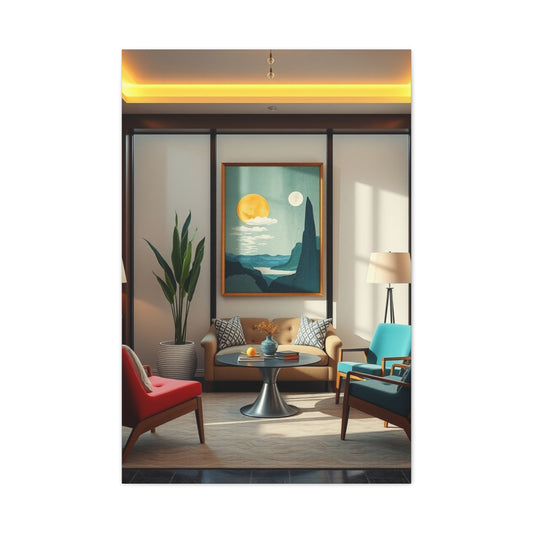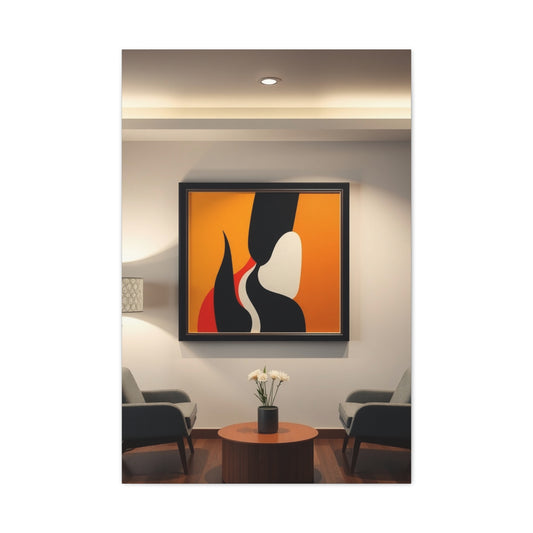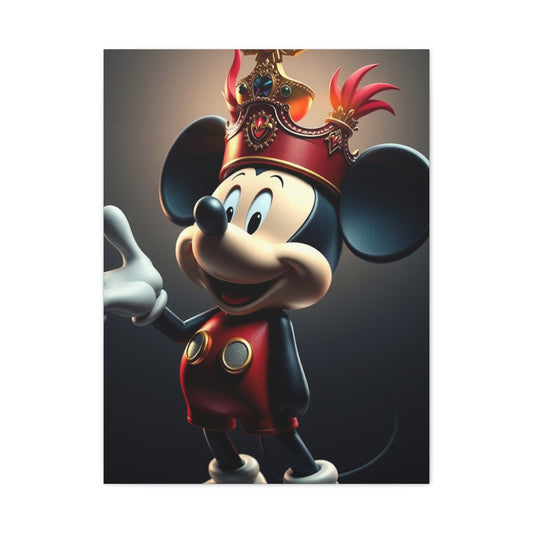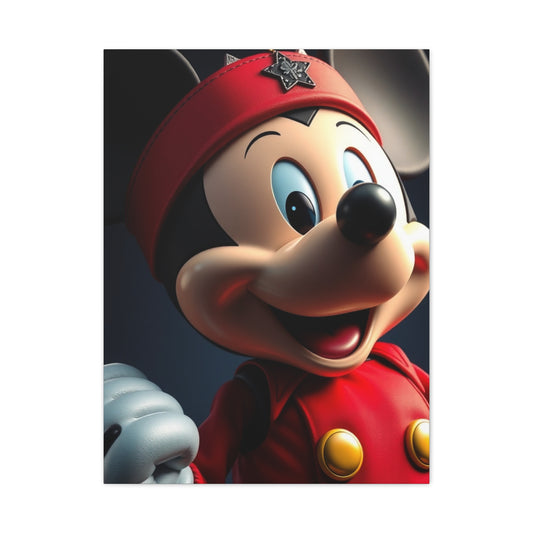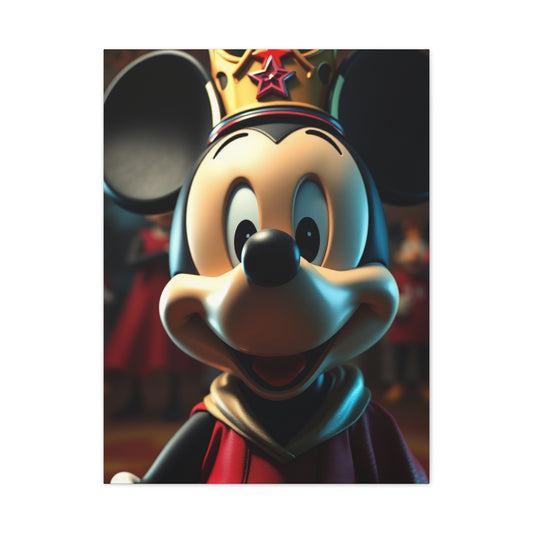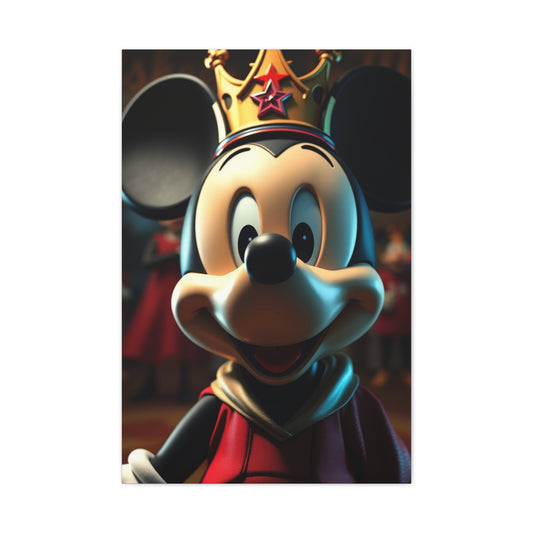In the world of art and home décor, few techniques offer the same level of versatility and precision as custom printing. With the aid of advanced digital technology, especially HP printers equipped with pigment ink, artists and individuals can transform their digital creations into vibrant, long-lasting works of art. This method is particularly ideal for those seeking high-quality custom prints that capture every detail and nuance of the original artwork. Whether for personal spaces or commercial settings, the beauty of custom prints lies in their ability to bring digital art to life in a tangible way.
Image Preparation: The Foundation of Artistic Precision
The process of creating stunning canvas prints begins with the careful preparation of the digital image. Graphic design software allows artists to fine-tune every aspect of their artwork, from color adjustments to intricate details, ensuring the final design is as visually striking as possible. By perfecting these elements before printing, artists can ensure that the translated artwork remains true to their original vision when it is transferred to canvas.
Once the image has been prepared, it is ready for printing. The precision offered by HP printers equipped with pigment ink is unparalleled, ensuring that every fine detail is faithfully reproduced on canvas. The high resolution and accuracy of the printer enable the creation of vibrant, photo-realistic prints that preserve the artist's intentions in stunning clarity.
The Printing Process: Precision and Detail in Every Print
Using HP printers with pigment ink, the artwork is directly printed onto the canvas material. This modern printing technique offers a superior level of accuracy, with each ink droplet carefully placed to replicate the design. The result is a sharp, high-resolution print that brings the image to life with exceptional color depth and detail. Whether the artwork features a complex gradient or fine details, this method ensures that every aspect of the original design is captured in its entirety.
One of the key advantages of pigment ink is its durability. Unlike traditional dye-based inks, pigment ink is resistant to fading, even when exposed to sunlight or other environmental factors. This makes canvas prints produced using this technique ideal for both residential and commercial applications, where long-lasting quality is paramount. Additionally, the quick-drying nature of pigment ink speeds up the printing process, allowing for efficient production without sacrificing quality.
Enhancing the Art with Protective Coatings and Framing
Once the canvas print is dry, many artists choose to apply a protective coating to further enhance its durability. This coating not only helps to protect the print from dust and scratches but also improves its resistance to UV light, ensuring that the colors remain vibrant over time. For those who wish to give their canvas print a professional, gallery-ready look, stretching the canvas over wooden frames is a popular option. This technique adds depth and sophistication, turning a simple print into a visually striking piece of wall art.
Canvas prints can be displayed in various settings, from private homes to business spaces. When incorporated into a gallery wall or showcased as a focal point, a well-crafted canvas print becomes an integral part of the décor, elevating the visual appeal of any space.
Related Catagories:
Personalizing Your Space with Wallpics
One of the most exciting aspects of canvas printing is the ability to personalize the artwork. Wallpics offers the perfect solution for those looking to create custom photo tiles and wall art that reflect personal memories, milestones, and creative expressions. Whether you're looking to display family photos, travel memories, or abstract artwork, Wallpics makes it easy to transform digital images into tailored photo displays that add character and warmth to any room.
Custom photo displays also make thoughtful gifts, allowing individuals to share special moments and personal creations with others. By crafting unique and high-quality prints, people can give the gift of lasting memories that will be cherished for years to come.
The Artistic Impact of Canvas Printing
Printing on canvas using HP printers and pigment ink allows for the reproduction of artwork with remarkable fidelity. Artists can achieve vibrant colors, sharp details, and exceptional depth, all of which enhance the overall impact of the piece. This method ensures that the artwork remains true to its digital form, making it an excellent choice for those looking to preserve the integrity of their creations.
The versatility of canvas printing also makes it an ideal medium for various types of artwork. Whether it’s a stunning photograph, a detailed painting, or a modern graphic design, custom prints provide a high-quality way to showcase digital art. For those eager to bring their creative visions to life, the ability to produce prints that are both aesthetically pleasing and durable is a significant advantage.
The Benefits of Quick Turnaround Time
One of the significant advantages of digital canvas printing with HP printers is the quick turnaround time. Unlike traditional methods, which can involve labor-intensive processes and longer production periods, digital printing technology allows for faster production without compromising quality. This speed is especially beneficial for those working on tight timelines, such as businesses needing bulk prints for promotional purposes or individuals seeking last-minute custom gifts. The efficiency of digital printing ensures that orders are completed promptly, with each print maintaining the highest standards of craftsmanship.
Eco-Friendly Practices in Modern Printing
As environmental concerns continue to grow, many modern printing techniques, including digital canvas printing, are increasingly focused on sustainability. HP printers equipped with pigment ink use water-based inks, which have a lower environmental impact compared to traditional solvent-based inks. Additionally, the precise application of ink during the printing process reduces waste, as there is minimal overspray or excess ink. For environmentally conscious artists and consumers, this makes canvas printing a more eco-friendly option, allowing them to enjoy high-quality art while supporting greener practices.
Customizing Canvas Prints for Various Applications
Beyond personal décor, custom prints are incredibly versatile and can be tailored for a wide range of applications. From professional office spaces to event decorations, these prints can be customized to fit any setting. Businesses often use custom prints for branding purposes, displaying their logos, inspirational quotes, or key visuals on large pieces that make a statement in the workplace. Additionally, custom prints are frequently utilized for events like weddings or parties, where they serve as elegant, memorable décor pieces. Whether for commercial or personal use, the flexibility of custom prints allows them to seamlessly integrate into diverse environments.
The Evolution of Screen Printing – An Enduring Tradition in Art
While modern digital printing technology offers remarkable precision and efficiency, traditional techniques such as screen printing have maintained their relevance in the art world. This method, with its rich history and tactile nature, continues to captivate artists and designers alike. Screen printing, with its hands-on process, creates a unique aesthetic that sets it apart from digital methods, offering a sense of artistry that digital prints cannot replicate. In this section, we’ll explore the enduring charm of screen printing, its creative potential, and how it remains a popular choice for artists today.
A Hands-On Approach: The Process Behind Screen Printing
Screen printing is a manual process that involves transferring ink onto a surface through a mesh screen. This technique is often chosen for its ability to produce rich textures and the distinct feeling of craftsmanship that digital printing cannot replicate. The process begins with the creation of stencils that define the design. Each element of the design, particularly if multiple colors are involved, requires a separate screen. These screens are meticulously prepared, each one aligning with the corresponding color layer.
Once the screens are ready, ink is applied through the mesh onto the chosen material—whether it be fabric, paper, or canvas. This technique results in a thicker layer of ink compared to digital printing, which allows the creation of unique, tactile textures on the surface of the artwork. As a result, screen printing often has a more artisanal appeal, showcasing the depth and physicality of the piece.
Crafting Texture: The Artistic Depth of Manual Printing
One of the most distinctive aspects of screen printing is the physical texture it imparts to the final piece. Unlike the smooth, uniform finish of digital prints, screen prints have a raised texture where the ink is applied more generously, creating a dynamic, three-dimensional feel. This quality makes screen prints stand out when displayed, as the ink’s application creates variations in depth and texture that add visual and tactile interest.
This textured effect is especially appreciated in fine art, where the artist may use it to enhance the emotional impact of their work. Whether it’s the roughness of the ink or the layering of colors, the tactile sensation of a screen print makes it an ideal choice for those seeking to engage the viewer’s senses beyond mere visual appeal.
The Charm of Limited Edition Prints
Screen printing is ideal for creating limited edition runs, particularly because of the manual effort involved in preparing and printing each piece. Each screen print is a handcrafted work of art, and the process itself can be time-consuming. This labor-intensive nature makes screen prints a precious commodity, with each edition being numbered and signed by the artist. Collectors often seek these limited edition prints for their exclusivity, as they represent not only a piece of art but also the artist's personal touch and craftsmanship.
By producing limited editions, artists can maintain the integrity and uniqueness of their work, providing art lovers with a tangible connection to the creation process. Additionally, the demand for limited edition screen prints often increases over time, making them a valuable investment for art enthusiasts and collectors.
The Appeal of Bold and Vibrant Colors
Another key feature of screen printing is its ability to produce bold, vibrant colors. Unlike digital prints, where colors can sometimes appear muted or washed out, screen printing allows for intense saturation that makes each hue stand out. The thick layers of ink used in screen printing also contribute to this richness, resulting in colors that are more vivid and eye-catching than what can typically be achieved with digital methods.
For artists who want to make a strong visual impact, screen printing provides the opportunity to experiment with color in ways that are not possible with other techniques. The bold color contrasts and saturation can evoke powerful emotions and draw the viewer’s attention, making it an excellent choice for designs meant to make a statement.
Screen Printing for Merchandise and Promotional Art
Beyond the realm of fine art, screen printing is often used for merchandise production, such as custom clothing, posters, and promotional materials. Its ability to produce consistent, high-quality prints in large quantities makes it the go-to choice for businesses looking to create branded items or mass-produce designs.
For example, many popular clothing brands use screen printing for their t-shirt designs, taking advantage of its durability and the ability to apply bold graphics that will last for years. Similarly, posters for events, concerts, or promotional campaigns are often screen printed to ensure vibrant colors and consistent design across large runs. The technique’s efficiency in mass production has made it an essential tool for companies and artists alike.
The Versatility of Screen Printing Materials
One of the defining characteristics of screen printing is its ability to work with a wide variety of materials. Unlike digital printing, which is primarily restricted to paper or fabric, screen printing can be applied to almost any surface, from metal and wood to glass and plastic. This versatility makes screen printing an attractive option for artists and businesses looking to experiment with unconventional mediums.
For example, many artists create unique artworks by screen printing on wood panels, metal sheets, or even ceramic tiles, each surface adding its own distinct texture and character to the final product. This adaptability also extends to promotional products like custom tote bags, signage, or even home décor items. The ability to use different materials opens up a world of creative possibilities for both artistic expression and commercial applications.
Cost-Effectiveness for Large-Scale Production
While the initial setup for screen printing may require a significant investment in screens, stencils, and equipment, it becomes highly cost-effective when producing large quantities of the same design. For artists or businesses looking to create numerous prints, screen printing offers a more economical solution compared to digital methods, especially for mass production.
In bulk production, the cost per unit decreases as the number of prints increases. This makes screen printing ideal for creating promotional materials, branded merchandise, or even art prints that will be distributed in large numbers. The efficiency of the process, combined with its ability to deliver high-quality results at scale, ensures that screen printing remains a staple for industries requiring large runs of the same design.
The Unique Artistic Qualities of Canvas Printing – Precision, Vibrancy, and Longevity
While screen printing offers a tactile, handmade feel, canvas printing brings its own set of advantages that appeal to modern artists and decorators. The precision of digital printing and the exceptional vibrancy of colors it can achieve make it an ideal choice for those seeking to preserve the nuances of their original artwork. Canvas prints are particularly popular among interior designers, art collectors, and those looking to make a statement with their décor. In this section, we explore the distinct qualities of canvas printing, from its high-resolution reproduction to its lasting durability.
High-Resolution Reproduction: Capturing Every Detail
One of the greatest strengths of canvas printing is its ability to reproduce intricate details with exceptional clarity. Modern printing technology, particularly when using high-quality printers, ensures that every aspect of the original artwork is captured with high precision. Whether it’s fine lines, textures, or subtle gradients, canvas prints can retain the quality and integrity of the original design. This level of detail is difficult to achieve with traditional methods, such as screen printing, where intricate designs may be challenging to reproduce accurately.
Canvas prints are ideal for artists who prioritize showcasing fine details in their work. From the delicate shading in portraits to the texture of brushstrokes in abstract art, canvas printing provides a platform where the smallest nuances come to life. The ability to reproduce these details is a key reason why canvas prints are increasingly popular among collectors and decorators.
Vibrant and Rich Color Representation
Canvas printing allows for the vivid representation of colors, bringing depth and brilliance to any design. Digital printers are capable of producing a wide range of hues, achieving color saturation and richness that closely mirrors what the artist envisioned. The use of pigment-based inks further enhances the vibrancy, ensuring that the colors remain vibrant and true-to-life for years to come.
For artists who work with color as a key element of their design, canvas printing provides an ideal medium for translating their vision onto canvas. Whether it’s bold primary colors or soft pastel shades, the printing process captures the full spectrum of the original artwork, making it a perfect choice for creating eye-catching displays in both private and public spaces.
Longevity and Durability: Preserving Art for Generations
One of the most significant advantages of canvas printing is the longevity it offers. With advancements in digital printing technology, canvas prints can be produced with inks that are resistant to fading, even when exposed to sunlight or environmental factors. High-quality pigment inks, for instance, are known for their remarkable resistance to UV rays, which helps preserve the integrity of the artwork over time.
In addition to the longevity of the inks, canvas itself is a durable material that withstands the test of time. Canvas prints are often stretched over wooden frames, giving them additional strength and preventing warping. For collectors, this means that their artwork can be enjoyed for many years, retaining its original vibrancy and quality. The durability of canvas prints makes them a solid investment for both personal enjoyment and commercial applications.
Related Catagories:
Customizability and Personalization
Canvas printing offers an incredible degree of customization, allowing artists and designers to bring their personal touch to every project. Whether it's adjusting the size of the print, choosing a specific frame, or even adding personalized text, the canvas print process can be tailored to meet individual preferences.
The versatility of canvas printing also extends to its ability to adapt to various art styles. Whether an artist is creating a traditional oil painting or a modern digital piece, the printing process allows for seamless reproduction of the design. Additionally, canvas prints can be made to fit any space, from small portraits to large-scale pieces intended to be a focal point in a room.
The customization options available with canvas printing also make it a popular choice for personal gifts, such as family portraits or wedding photographs. By turning a cherished memory into a custom canvas print, individuals can create lasting mementos that hold emotional value.
Seamless Integration into Interior Design
Canvas prints have a timeless quality that makes them an excellent choice for enhancing the atmosphere of any room. Their ability to blend seamlessly into various décor styles—from contemporary to traditional—has made them a favorite among interior designers. Whether it's a single statement piece or a gallery wall of smaller prints, canvas prints can elevate a space with their artistic flair.
The flexibility in framing options also allows for canvas prints to be displayed in a way that complements the overall aesthetic of a room. For instance, a gallery-wrap canvas print can create a modern, minimalistic look, while a framed canvas can lend a more classic or formal feel to the décor. The adaptability of canvas prints makes them an essential element in designing spaces that reflect personal taste and style.
Exploring the Creative Process – The Role of Digital and Traditional Printing in Modern Art
The world of artistic reproduction has evolved dramatically, offering artists and designers a wide array of options for translating their visions onto physical media. While traditional techniques like screen printing have stood the test of time, digital methods, particularly those utilizing high-quality pigment-based ink, have redefined the way artists approach their craft. In this final segment, we explore the creative journey behind these two methods, emphasizing their influence on modern art and design.
The Intersection of Technology and Creativity
One of the most exciting aspects of digital reproduction is the seamless integration of technology with the artist's creativity. Digital printing processes empower artists to experiment with color schemes, textures, and designs in ways that were once unimaginable. The precise control over each layer of the image allows for an unmatched level of detail and nuance. Artists can manipulate their designs digitally before transferring them onto the final medium, ensuring that every aspect of their work aligns perfectly with their vision.
Moreover, digital printing provides a significant advantage when it comes to color correction and adjustment. Artists no longer have to rely on trial and error with physical paints or inks. Instead, they can adjust the color balance and hues digitally, ensuring that the final piece matches the exact vision they have in mind. This precise process opens up new opportunities for experimentation, giving artists the freedom to push creative boundaries without being limited by traditional constraints.
The Tactile Connection with Traditional Techniques
While digital printing offers precision and flexibility, traditional methods like screen printing hold a unique place in the hearts of many artists. The tactile nature of screen printing—where ink is manually pushed through mesh onto various surfaces—creates a physical connection between the artist and their work. This hands-on approach, with its raw, organic qualities, offers a sense of authenticity and craftsmanship that digital methods simply cannot replicate.
The process itself is an experience, one that requires the artist to be fully engaged with every layer of the work. There’s an artistry in the manual application of each color, a rhythm that builds with every stroke. This tactile connection often results in one-of-a-kind pieces with imperfections that add to their charm and character. It’s this uniqueness that makes traditional techniques so appealing to collectors and art lovers, who seek works that feel deeply personal and original.
Sustainability and Environmental Impact
As the demand for sustainable practices grows in the art world, both digital and traditional methods are increasingly being scrutinized for their environmental impact. Digital printing processes have made strides in reducing waste by allowing artists to print only the quantity they need, as opposed to large-scale runs. Additionally, advances in ink technology have led to the development of more eco-friendly options, which are not only better for the environment but also safer for artists to work with.
On the other hand, traditional printing techniques like screen printing can be more resource-intensive, particularly when large quantities of ink are required for each print. However, many screen printers are shifting toward more sustainable practices by using water-based inks and reducing the use of plastic-based materials. As eco-consciousness becomes a key consideration for both consumers and artists, the printing industry is evolving to meet the demand for greener alternatives.
The Evolution of Customization in Art
In the digital age, customization has become a cornerstone of artistic expression. Digital techniques offer unparalleled flexibility, allowing for tailored creations that can be made to suit any individual’s taste, style, or space. Whether it’s adjusting the scale of an image, choosing the perfect frame, or even incorporating text or personalized elements into a design, digital methods offer an extraordinary level of control. This level of customization not only allows artists to cater to a wide range of clients but also provides a unique opportunity for collectors to invest in artwork that truly resonates with them on a personal level.
Traditional methods, while less flexible, still offer a degree of customization. For instance, the layering process in screen printing allows for the creation of textured effects that lend a personal touch to each piece. Additionally, artists who work with traditional media often take pride in their ability to adapt their techniques to create unique variations of their work. This approach, while less predictable than digital printing, is a key part of what gives traditional works their authenticity and charm.
The Future of Artistic Reproduction: Hybrid Approaches
Looking toward the future, it’s clear that both digital and traditional methods will continue to coexist and complement each other. Hybrid approaches, where artists combine digital printing with traditional techniques, are becoming increasingly popular. For example, artists may print a digital design onto a canvas, then add hand-painted touches to create a mixed-media piece. This blend of the precise with the organic allows for an exciting new direction in artistic expression.
These hybrid approaches also open up new possibilities for artists to experiment with different textures, materials, and mediums, creating a dynamic and evolving landscape for contemporary art. As technology continues to advance, the boundaries between digital and traditional techniques will blur, offering artists even more tools to bring their creative visions to life.
Innovations in Printing Technology: Enhancing Artistic Freedom
Advances in printing technology continue to expand the creative horizons for artists. One of the most significant developments is the rise of specialized printers designed for fine art reproduction. These printers, equipped with cutting-edge technology, offer artists the ability to print on a variety of unique materials such as textured papers, metals, and even fabrics. This expanded material selection allows artists to push their creative boundaries and experiment with new textures, surface finishes, and visual effects.
With the ability to print on unconventional surfaces, artists can create visually compelling pieces that blur the lines between traditional mediums like painting and newer, more experimental approaches. This innovation in printing technology offers an entirely new dimension to art, giving creators the freedom to think outside the box and design in ways that were previously impossible with older, more conventional printing methods.
The Intersection of Digital and Physical Spaces in Artistic Expression
As more artists embrace digital technology, the boundaries between the digital and physical worlds are increasingly becoming blurred. Artists can now create immersive experiences that extend beyond the physical canvas, incorporating elements of virtual reality (VR), augmented reality (AR), and interactive media into their works. These technologies not only add a layer of interactivity but also invite viewers to engage with art in new and dynamic ways.
The integration of these digital elements with traditional print media is an exciting new direction in artistic practice. By incorporating motion, sound, or even touch-responsive features into their work, artists can create multi-sensory experiences that fully engage viewers. This fusion of digital and traditional art opens up new possibilities for expressing complex ideas, emotions, and concepts in ways that transcend the limitations of traditional visual art alone.
Cultural and Historical Impact of Artistic Reproduction Techniques
Both digital and traditional printing methods carry deep cultural and historical significance. For centuries, traditional printmaking techniques like screen printing and lithography have been used to create cultural icons and historical masterpieces. These methods often carry a rich history that connects artists with their predecessors, drawing on age-old techniques and practices that have evolved over generations.
In contrast, the advent of digital printing has revolutionized how art is reproduced, democratizing access to high-quality prints and allowing artists to share their work with a global audience. The accessibility and affordability of digital methods have led to a rise in independent artists who can now reach wider audiences without relying on expensive gallery spaces or traditional publishing routes. This shift has had a profound impact on the art world, allowing for greater diversity of voices and perspectives to be heard and seen in the public sphere.
The Role of Art Collectors in Shaping Printing Trends
Art collectors play a significant role in shaping the trends and directions of artistic reproduction. As collectors seek out new and innovative pieces, they influence the demand for certain printing techniques and mediums. For instance, the growing popularity of fine art prints in high-end galleries and auction houses has spurred the demand for digital printing technologies that can replicate original works with impeccable accuracy and quality.
Moreover, collectors are increasingly valuing limited-edition prints and one-of-a-kind pieces, which drives artists to explore new ways to differentiate their work. While digital printing allows for high-quality reproduction, the allure of unique, handcrafted elements in screen printing continues to captivate collectors who appreciate the tactile nature of the work. The role of the collector, therefore, not only influences the market but also encourages artists to innovate and refine their techniques to meet the evolving tastes of the art world.
Collaboration and Cross-Disciplinary Innovation
One of the exciting developments in the modern art world is the increasing collaboration between artists, technologists, and engineers. These cross-disciplinary partnerships have led to new breakthroughs in printing techniques, material sciences, and even the integration of artificial intelligence (AI) into the creative process. By working together, artists and technologists are able to create new tools that facilitate the creative process, allowing for faster, more accurate, and more dynamic art creation.
For instance, some artists are now experimenting with AI algorithms that generate artwork based on specific inputs or data sets, merging technology with human creativity. These collaborations lead to innovative approaches that challenge traditional notions of authorship and creativity, opening up new possibilities for artistic expression. As technology continues to evolve, it is likely that the boundaries between different creative disciplines will continue to blur, resulting in exciting new forms of art and artistic collaboration.
Personalization and the New Frontier of Artistic Expression
As artists continue to explore the boundaries of their craft, the shift towards personalized and bespoke artworks becomes increasingly significant. Whether it’s through the precision of digital printing or the hands-on craftsmanship of screen printing, each method offers the opportunity for deep personalization. Artists can infuse their work with individuality and uniqueness, creating pieces that resonate on a more personal level with their audience. This trend toward custom artwork not only enhances the connection between creator and viewer but also encourages the reimagining of what art can represent in the modern world. The diversity of printing techniques allows artists to break free from conventional limitations, offering endless possibilities for self-expression and connection.
The Democratization of Art in the Digital Age
The impact of new printing technologies extends beyond the artist’s studio, influencing the broader art market and how art is consumed. With digital reproduction, the accessibility of high-quality artwork has expanded, allowing more people to engage with art in meaningful ways. Collectors no longer need to rely on traditional galleries for access to stunning, authentic pieces; instead, they can find unique works available through online platforms and digital storefronts. This democratization of art makes it possible for emerging artists to reach global audiences, while also providing art lovers with a broader spectrum of works to explore and enjoy. As this trend continues to grow, the art world will undoubtedly see new waves of creativity and innovation that redefine how art is shared and appreciated.











